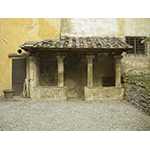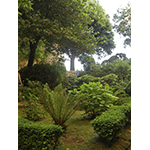Hanging gardens of Palazzo Guicciardini
Belonging in the distant past to the Capponi family and, since the 16th century, to the Bardi di Vernio, the palazzo owes its present aspect to the remodelling carried out in the 19th century by its new owners, Ferdinando Guicciardini and his son Carlo. At the instructions of the latter the architect Giuseppe Poggi, of whom the project was commissioned, transformed not only the interior of the building but also the adjacent garden, raising an elevated hillock over which a path connected the ground-floor loggia to the upper floor. The little garden, originally planned as an orchard, had assumed notable botanical importance already by the time of the Bardi, having been used to cultivate rare and exotic plants such as the Camelia japonica, the Fuchsia coccinea, the Ginko biloba (also called "tree of the forty scudi" due to the exceptionally high price at which it was purchased), and the famous "Goa lily", which had been praised in the 17th century by Lorenzo Magalotti, Secretary of the Accademia del Cimento. Around 1790, Count Piero Bardi had brought from London a specimen of the Magnolia grandiflora, while from France he imported a "rosa gallica holoserica", which was also called, from the name of its owner, "Bardi's black rose". Although the garden has lost any scientific interest today, the very particular structure conferred on it by Poggi still confers on it a fascination of Romantic stamp.
****************************
Texts by Elena Fani
English translation by Catherine Frost
Last update 16/apr/2009





